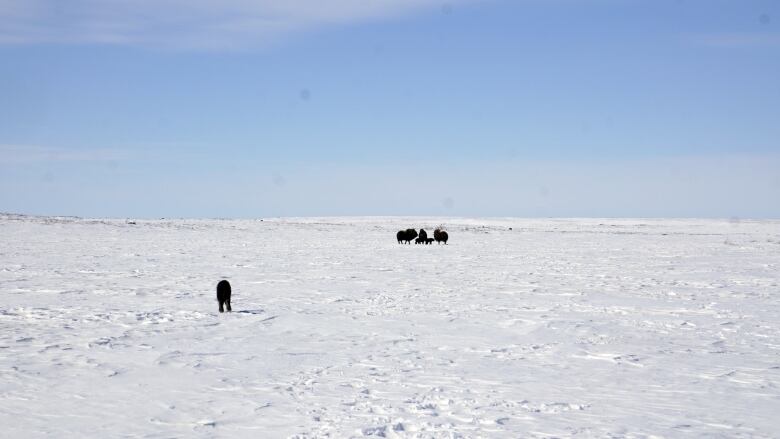Baby muskox found near Gahcho Ku mine reunited with family
Group of muskox located using drone, accepted calf after 3 reunification attempts

When a group of workers went to do maintenance on a water line on an N.W.T. mine property Sunday, they weren't expecting to be part of an animal reunification mission.
But when they went to the Gahcho Kumine site, they discovered a brand new baby muskox all by its lonesome, said Tom Ormsby, a spokesperson with DeBeers Canada, which operates the mine located 280 kilometres northeast of Yellowknife.
"In fact the umbilical cord was still visible, attached to the calf."
The story was first reported Friday by CKLB.
The workers immediately contacted the mine's environmental teamas per mineprotocol, Ormsby said. When they arrived, they cordoned off the area and used a drone to finda small group of adult and babymuskoxen located a couple of kilometres away.

The environmental team then tried to contact the N.W.T.'s Department of Environment and Natural Resources aboutwhat to do next, but because it was the weekend, they were unable to reach anyone.
Monday morning, the teamfound the calf located in the same area. Environment officials advised them to try to place the baby muskoxnear the group of muskoxen and then back away, Ormsby said.
According to the Department of Environment, a renewable resource officer gave mine staffa permit to relocate the calf.
"What they did was bundle it up, got some snow machines and a sled and went out and used the drone again to try to track down where the group was," Ormsby said, adding the group of muskox had moved a considerable distance away by that point.
The first time the environmental team tried to leave the calf, it turned and walked back toward them, Ormsby said. Asecond attempt also failed, but the third time was a charm.

"One of the adults in the group then came over to the calf and started licking its face and nuzzling it and then they all moved off as one unit afterwards," he said.
"They watched it essentially move off across the horizon with the group. It turned out well."
Ormsby said they don't knowwhy or how the calf got separated from the other muskox. But through the drone they noticed wolf, grizzly bear and caribou tracks in the area.
"The situation was resolved through the best possible outcome and [environment]officers and biologists were happy to assist with the successful reunion," a spokesperson for the territory's environment department told CBC in an email.












_(720p).jpg)


 OFFICIAL HD MUSIC VIDEO.jpg)
.jpg)



























































































